Common Flowers Along the Towpath
It's summer time, we thought it would be a great time to write about the wild flowers found on the waterways and towpaths of the UK.
Rosebay Willowherb (Chamerion angustifolium)
Rosebay Willowherb is a tall plant with pink flowers rising up a 1.5 meter flower spike, it flowers June to September. It's leaves are lance-like and are arranged in spiral formation up its stem.
Rosebay Willowherb was once a scarce woodland plant, but has grown in numbers as a result of two World Wars clearing huge areas of forest and burning the ground in town and countryside, just the right conditions for this plant to thrive in. One of its common names in the South East, 'Bombweed', alluding to this takeover.
Each plant can produce up to 80,000 seeds the heat from fires and bonfires can help to germinate them, hence another common name of 'Fireweed'.
***
Great Willowherb
Similar to Rosebay Willowherb, Great Willowherb is a large herb that flourishes on damp ground, such as wet grasslands, ditches, riversides and woodland clearings. Deep pink flowers appear on the top of hairy stems from July to August and its fluffy seeds are dispersed by the wind. It grows up to 2 metres high and flowers from June to September.
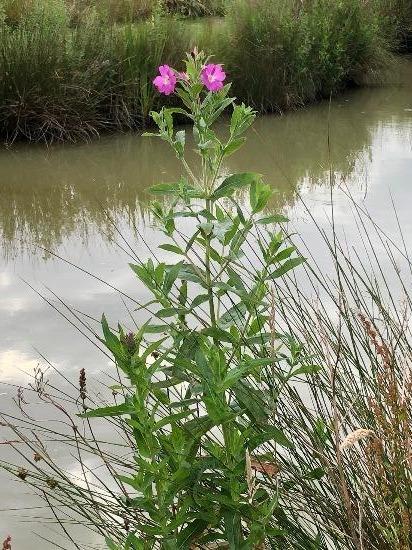
***
Purple Loosestrife (Lythrum salicaria)
Purple-loosestrife is a herbaceous perennial that can be found in wet habitats, such as canal banks reed beds, fens, marshes and riverbanks, where its impressive spikes of magenta purple pink flowers rise up among the grasses. Many tall stems can grow from a single plant. It flowers between June and August, when its nectar becomes a valuable food source for long-tongued insects, such as Brimstone butterflies, Red-tailed Bumblebees and Elephant Hawk-moths.
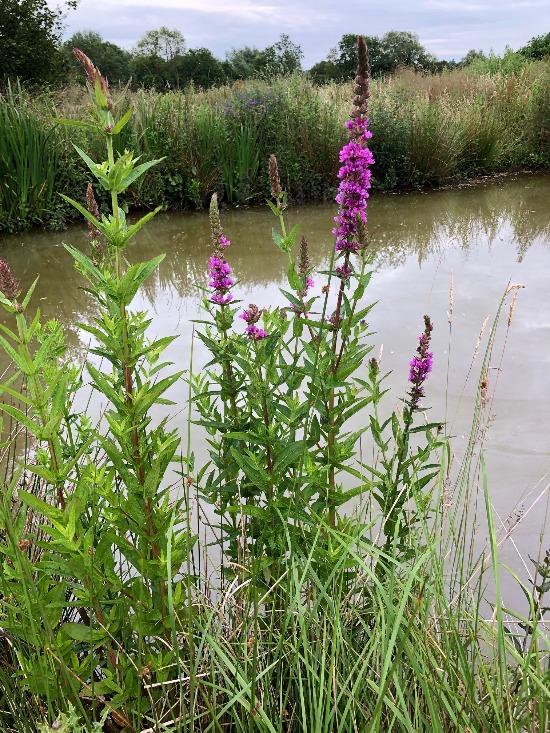
***
Oxeye Daisy (Leucanthemum vulgare)
The Oxeye Daisy has white petals surrounding a bright yellow centre. Flowers grow in solitary heads and are around three to five centimetres wide, flowering from Spring until the end of summer. The yellow centre of the daisy is made up of many small flowers which hold nectar, a food source for various pollinating insects, including butterflies, bees and hoverflies.
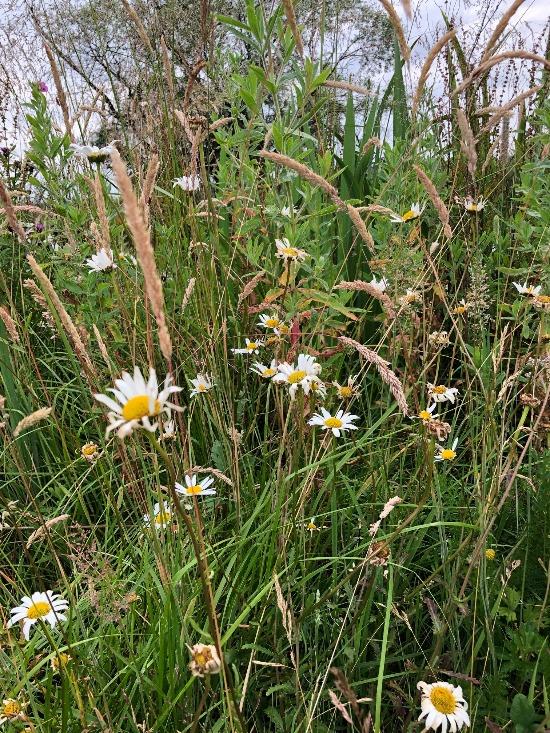
***
The Common Bluebell
Check out the woodlands next to our canals and waterways during May time or search online for bluebell woods that allow visitors to walk among the bluebells.
Scientific name: Hyacinthoides non-scripta. Bluebells are perennial bulbous herbs with flowering stems to about 50cm tall. They spend most of the year as bulbs underground and emerge to flower during April and May. The leaves are around 7mm to 25mm wide and 45cm long. Strap-shaped with a pointed tip. They are smooth and hairless with a succulent appearance. Up to 20 sweetly-scented flowers are borne on a flower stalk which droops or nods to one side. Flowers are bell-shaped and can be blue, white or rarely pink. Each flower has 6 petals with recurved (up-turned) tips. Anthers have white-cream coloured pollen.
Early flowering makes the most of the sunlight that reaches the woodland floor before the full woodland canopy casts its shade. Millions of bulbs may grow closely together in one wood, creating one of nature’s most stunning displays. A significant proportion of the world's bluebells grow here in the UK. You'll find them in broadleaved woodland, along hedgerows and in fields.
***
Water Mint
Water Mint grows in damp places and has aromatic leaves that can be used to flavour food and drink. It has lilac/purple flowers during the summer time. Gathering wild food can be fun, but it's best to do it with an expert - The Wildlife Trust hold events run by experts.
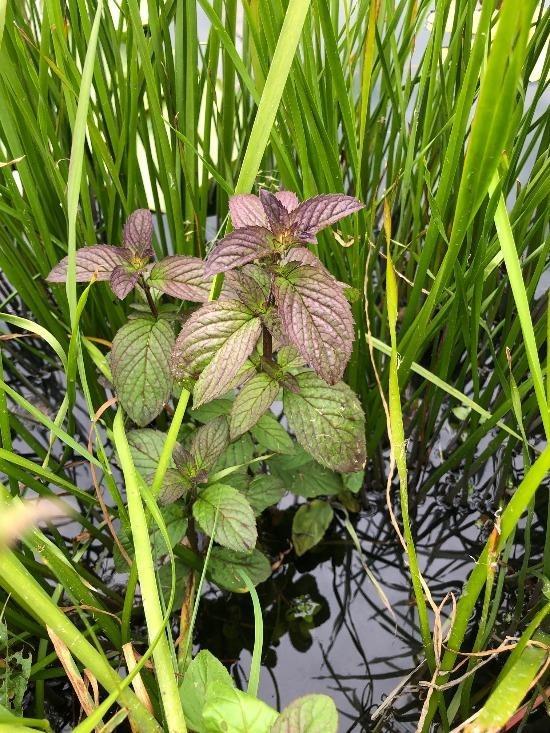
There are about 14 or 15 species or hybrids of mint growing in the UK, most of which have very aromatic leaves. Water Mint prefers damp habitats and grows in water, making it a good choice for wildlife ponds and bog gardens. Its leaves can be used in the same way as other mints, flavouring cooking and drinks. It flowers from July to October and spreads vigorously using its creeping runners.
Water Mint is very attractive to a variety of insects, including Small Tortoiseshell, Peacock and Comma butterflies, as well as the Green Tortoise Beetle.
***
Yellow Iris
The large, sunshine-yellow flowers of the Yellow Iris brighten up the margins of our waterways, ponds, wet woods, fens and marshes. Also called the 'Flag Iris', its outer petals have a characteristic 'droop' The yellow Iris can often be found along canal and river banks, it grows to a height: 40-100cm and flowers from May to August.
***
Meadow Sweet
As its name suggests, Meadowsweet is a sweet-smelling flower of damp meadows, ditches and riverbanks. Look for frothy creamy coloured clusters of flowers on tall stems.
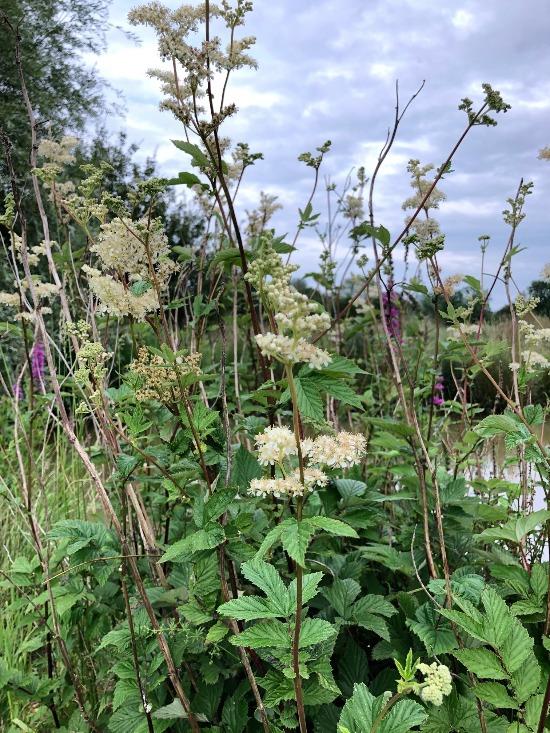
Meadowsweet is a member of the rose family that favours wet habitats, such as ditches, damp meadows and riverbanks. Its leaves are sometimes covered with a bright orange rust fungus. It blooms from June to September, with sprays of tiny creamy-white flowers standing atop tall stems. Its sweet smell encouraged people to display it in their houses in past times; but if crushed, it can smell more like antiseptic!
***
Lady’s smock also known as Cuckoo Flower
Often called Cuckoo Flower because it flowers in spring, is another delicate beauty whose pale pink flowers give a tapestry-effect through wet meadows.A perennial of damp, grassy places like wet meadows, ditches and riverbanks, as well as roadside verges. Its pale pink flowers bloom from April to June and are thought to coincide with the arrival of the first Cuckoo - a sure sign that spring has arrived at last.
Did you know that the common name 'Lady's-smock' arises from the cupped shape of the flowers. However, 'smock' was once a slang term for a woman and the name may have alluded to certain springtime activities in the meadows!
***
Ragged Robin
Ragged robin (Lychnis flos-cuculi) With open, ragged-looking pink petals and branching red stems, ragged robin is a favourite with the bees and butterflies who love it's nectar. There is a naturally occurring white-flowered form too. Flowers from May to August, it's conservation status is declining.
***
Cowslip
It's leaves are dark green and wrinkled, the leaf is quite wide but narrows towards the end. The leaf edges are toothed, and a light cream-green midrib can clearly be seen in the centre of the leaf. The leaves grow in a basal rosette formation. Flowers are yellow in colour, the bell-shaped flowers have five petals with small indents in the top edge of the petals. The flowers are enclosed by a long green tube-shaped calyx. The flowers are found in clusters on each plant, which tilt to one side.
An early flowering plant this species is important for wildlife, providing nectar for various insects, such as bees, beetles and butterflies, like the brimstone. Cowslip is also a food plant for the Duke of Burgundy butterfly.
Uses and Folklore of the Cowslip
The cowslip was used to treat sleeping problems because it is said to have a sedative quality, as well as the flowers being used to help treat coughs.
Cowslips were traditionally picked on May Day to adorn garlands but also other celebrations, such as weddings, as they are pretty flowers. Cowslips have also been called ‘St. Peter’s keys’ or ‘keys of heaven’ because the one-sided flower heads looked like a set of keys, and it has been said that cowslips grew where Peter dropped the key of Earth.
What wild flowers have you seen on along the waterways?
Keep your eyes peeled along the towpaths and river banks and let us know what flowers you find there, you can comment below, we'd love to know!